Here is some minimal data. Please tell us more about the background of your data. In general, more or less data will always change the way you see your relationship. As suggested, logistic regression looks like this with more or less data:
library(tidyverse)
cars <- as_tibble(mtcars[,c("vs", "mpg")])
outside <- subset(cars, mpg < 17 | mpg > 23)
inside <- subset(cars, mpg >= 17 & mpg <= 23)
ggplot(cars, aes(x = mpg, y=vs)) +
geom_point(size=2) +
geom_smooth(method = "glm",
method.args = list(family = "binomial"),
se = FALSE, colour="black") +
geom_point(data=inside, aes(x = mpg, y=vs), size=5, col="blue") +
geom_smooth(data = inside,
method = "glm",
method.args = list(family = "binomial"),
se = FALSE, colour="blue") +
geom_point(data=outside, aes(x = mpg, y=vs), size=3, col="red")+
geom_smooth(data = outside,
method = "glm",
method.args = list(family = "binomial"),
se = FALSE, colour="red")

Do you consider outside values outlier? Although we see a curve for each dataset (total, inside, outside), the relationship is not always statistical significant. Here are logistics regression on the samples:
model_inside = glm(vs ~mpg, family = binomial(link = 'logit'), data = inside)
model_outside = glm(vs ~ mpg, family = binomial(link = 'logit'), data = outside)
model_complete = glm(vs ~ mpg, family = binomial(link = 'logit'), data = cars)
library(stargazer)
stargazer(model_inside, model_outside, model_complete, type = "text")
===============================================
Dependent variable:
-----------------------------
vs
(1) (2) (3)
-----------------------------------------------
mpg 0.403 0.614 0.430***
(0.343) (0.418) (0.158)
Constant -7.791 -15.058 -8.833***
(6.879) (10.782) (3.162)
-----------------------------------------------
Observations 14 18 32
Log Likelihood -8.799 -2.240 -12.767
Akaike Inf. Crit. 21.597 8.479 29.533
===============================================
Note: *p<0.1; **p<0.05; ***p<0.01
On each subsample (inside/outside) there is no significant relation.
Is there a relationship between X and Y in the outside range?
cor.test(outside$mpg,outside$vs)
Pearson's product-moment correlation
data: outside$mpg and outside$vs
t = 7.7269, df = 16, p-value = 8.677e-07
alternative hypothesis: true correlation is not equal to 0
95 percent confidence interval:
0.7195044 0.9578132
sample estimates:
cor
0.8880613
For this test data, yes.
